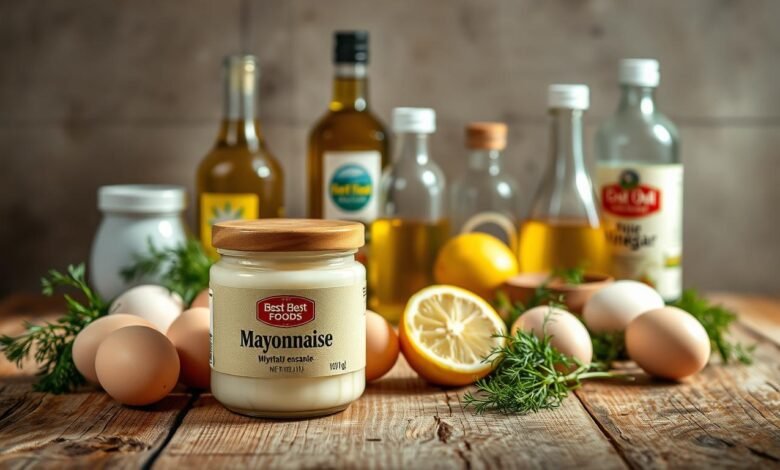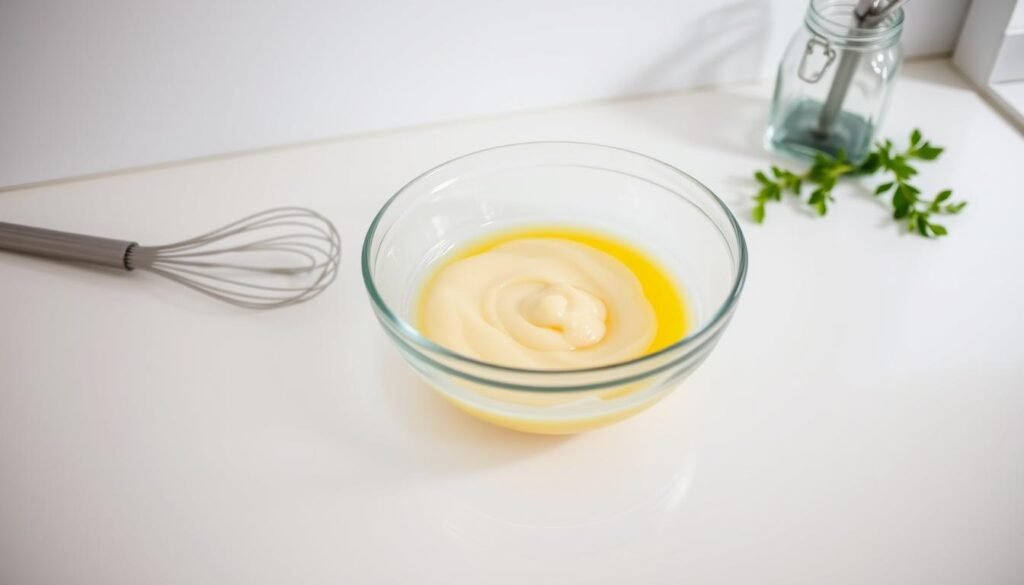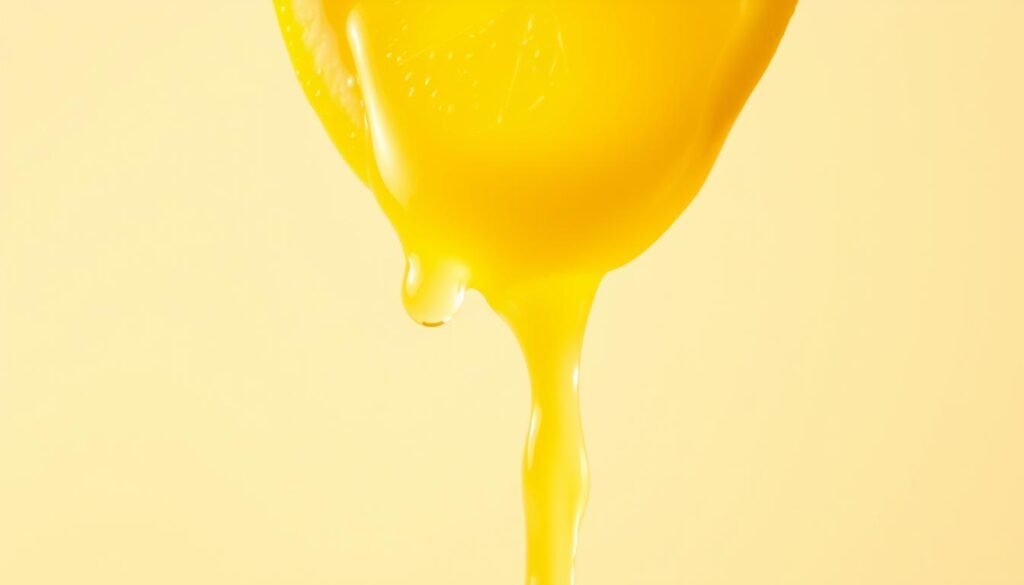
You probably remember the first jar that felt like home — the smell, the creamy glide on a sandwich, the small, comforting taste that made a meal feel complete.
That memory matters. Here you’ll find a clear, practical look at how the classic jar is built and why it tastes the way it does. You’ll learn how eggs, oil, mustard, and acids work together to create texture, stability, and a signature tang.
This short guide keeps the process simple. It explains the key steps — like adding oil slowly with a whisk or a spouted cup — and the gear choices that speed or steady the job. You’ll also see how small tweaks to acid and salt change the flavor so the finished spread matches what you expect from a jar you trust.
Key Takeaways
- You’ll get a practical overview of ingredient roles and how they shape texture.
- Gradual oil addition and steady whisking are essential for a stable emulsion.
- Tools from whisk to immersion blender change speed and control.
- Adjusting acids and salt refines the tang to match familiar profiles.
- Expect a visual shift from thin to glossy, thick spreadability by the end.
What you’ll learn today: ingredients, technique, and flavor you can trust
You’ll walk away knowing which tools and tweaks deliver a reliable, glossy spread every time.
This short guide sets a clear goal: in under ten minutes you can use a small bowl and whisk, a food processor, or an immersion blender to get a smooth, stable emulsion.
- You’ll choose the right tool for speed or control and plan the oil drizzle path before you start.
- You’ll learn which ingredients matter most—eggs for emulsifiers, mustard for stability, and acid for balance—and how oil affects texture and finish.
- You’ll stage items at room temperature, use pasteurized eggs if desired, and follow checkpoints so the mix thickens evenly.
| Tool | Time | Control | Best use |
|---|---|---|---|
| Bowl + whisk | 6–10 min | High control | Small batches, manual finesse |
| Food processor (small bowl) | 2–4 min | Good | Consistent, quick recipe runs |
| Immersion blender | 1–2 min | Very good | Near-instant emulsion, one-cup batches |
| Oil choice | – | – | Neutral oils for base; light olive for character |
Keep tasting near the end and adjust salt, mustard, or acid sparingly. Pause to scrape the sides if thickening stalls. With these steps, you’ll make a reliable homemade mayonnaise that works across sandwiches, salads, and sauces.
best foods mayonnaise ingredients: what’s inside and why it works
Behind a smooth jar lies a handful of precise choices that shape texture and taste. You’ll see how each element plays a role so you can copy the classic profile at home.
Eggs and yolk: the emulsion engine
Egg and egg yolk supply lecithin and proteins that hold oil and water together.
You can use whole eggs for a forgiving mix or go yolk-only for extra richness and stability.
Mustard: flavor plus stability
Mustard does double duty: it adds a touch of flavor and helps keep tiny oil droplets suspended.
Oil choices: neutral base, olive oil options
Choose a neutral oil for a clean profile. Safflower, sunflower, or canola give a classic result.
Use a light olive oil for character, but add it slowly or only part of the total oil to avoid bitterness.
| Oil type | Effect | When to use |
|---|---|---|
| Neutral (canola/sunflower) | Clean, mild | Everyday base |
| Light olive oil | Fruity, rounded | Mix with neutral oil |
| Avocado | Subtle flavor | Small batches |
Acid balance: white wine vinegar vs. lemon juice
Acid tightens the emulsion and sharpens taste. Use apple cider vinegar for a crisp snap.
Choose lemon juice when you want a fresher, citrus lift. Both improve stability and temper the fat.
Salt and optional garlic: finishing the sauce
Adjust salt after the mix thickens so you don’t over-season. Add finely grated or roasted garlic last for an aioli twist.
- Keep all items near room temperature and work steadily in a bowl.
- Taste at the end and tweak acid or salt sparingly.
Tip: Understanding how oil builds body, yolk binds, and acid sharpens will help you reproduce a familiar, store-style spread for sandwiches and salads.
Make mayonnaise at home: a fail‑proof recipe that mirrors the classic
With steady hands and the right gear, you can recreate the classic jar in minutes.

Equipment choices
Choose your tool: a food processor small bowl, an immersion blender with a tall jar, or a whisk and a stable bowl if you work by hand.
Step‑by‑step
Stage an egg and a level teaspoon of mustard in the bowl. Add a splash of vinegar and a pinch of salt.
Process for about 20 seconds, then add the seasonings and run for another seconds to prime the mix.
With the machine running, begin to add oil in tiny drops until roughly one quarter is incorporated.
Then continue to pour oil in a thin stream. Watch the mix go from translucent to glossy and mayonnaise thick.
Texture checks and finishing
When a spoon leaves a trench that holds, stop and taste. Adjust with a teaspoon of lemon juice or a little more salt.
Troubleshooting
If the emulsion breaks, start a clean cup with a fresh yolk and 1/2 teaspoon vinegar or lemon juice. Slowly drizzle the broken mixture back in until it re‑forms.
If too thin, blend in more oil slowly. If too stiff, whisk in cold water a teaspoon at a time to loosen the texture.
- Use steady motion by hand, or a steady machine speed, to keep droplet size even.
- Measure: a cup total oil, added slowly; a tablespoon or teaspoon measurements keep balance.
Flavor profile and tang: Best Foods vs. Hellmann’s, and how your choices shape taste
The difference between regional jar favorites often comes down to how acid and oil are used. In the western U.S., one brand is often described as a touch tangier than the eastern counterpart. Their formulas are similar today, but small acid shifts create that perceived edge.

Lemon juice and white wine vinegar: dialing in the tang
Use apple cider vinegar or a splash of lemon to shape brightness. Apple cider vinegar gives a clean, crisp snap. Lemon adds aromatic lift and a fresher finish.
Build tang in layers by pairing vinegar and lemon in a bowl. Taste as you go so the acid feels bright, not sour.
Neutral oils vs. olive oil: body, aroma, and finish
Neutral oil keeps the profile soft and familiar. Adding half oil as olive oil brings a gentle olive aroma and rounder mouthfeel.
- Choose a light, fruity olive to avoid bitterness.
- Adjust salt and acid last so olive character doesn’t mask the bright edge you want in a sauce or sandwich.
- Small tweaks in vinegar lemon or vinegar lemon juice ratios will nudge your homemade mayonnaise toward either commercial style.
Turn your mayonnaise into sauces, spreads, and salads
One fresh batch is a flexible base that saves meal prep time and raises weekday lunches. Use a clean bowl to fold in fillings gently, or blend add-ins in the jar for quick sauces.
Everyday recipes
Make egg salad, tuna salad, or potato salad by mixing chopped protein, a splash of vinegar or lemon juice, and a few teaspoons of seasoning. For coleslaw, toss shredded cabbage with a cup of homemade mayonnaise and a tablespoon of vinegar.
Quick sauces
Whisk spicy mayo with a tsp of sriracha. Stir chopped pickles and herbs into tartar sauce. Mix ketchup and spices for fry sauce. Taste and adjust by tablespoon.
Classic spins
For aioli, add minced garlic and a little lemon juice. Use the jar to shake tartare or Marie Rose for shrimp. These garlic-forward options lift fries and seafood.
Storage and food safety
Portion into a clean jar, label the date, and refrigerate. Many cooks keep homemade mayonnaise up to two weeks. If you worry about raw egg, use pasteurized eggs. Keep tools cold and limit room time.
| Use | Add-in | Typical measure | Quick tip |
|---|---|---|---|
| Egg salad | Chopped egg, mustard | 1 cup mayo, 1 tbsp mustard | Fold in with a bowl to keep texture |
| Spicy mayo | Sriracha, lemon juice | 1/4 cup mayo, 1 tsp sriracha | Adjust heat by teaspoon |
| Tartar sauce | Pickles, herbs | 1/2 cup mayo, 2 tbsp chopped pickles | Chill 30 minutes for flavors to meld |
| Aioli | Garlic, olive oil | 3/4 cup mayo, 1 clove garlic | Mince garlic fine so it blends by hand |
Conclusion
Finish with a steady hand: slow the stream of oil, count a few steady seconds while you blend, then taste and adjust. ,
You now have a reliable recipe to make mayonnaise—set up a small bowl or processor, stage eggs and acid, and pour oil in a thin stream until the texture turns glossy and mayonnaise thick.
If a batch breaks, start a fresh egg yolk with a splash of vinegar or lemon juice and add the broken mix bit by bit until it comes back. Keep oil added slowly to fine‑tune body, or loosen with a tablespoon of cold water if needed.
Choose neutral oil or a half oil swap with olive oil for nuance. Chill in a clean jar, use pasteurized eggs if you prefer, and store in the fridge for safe, consistent results every time.